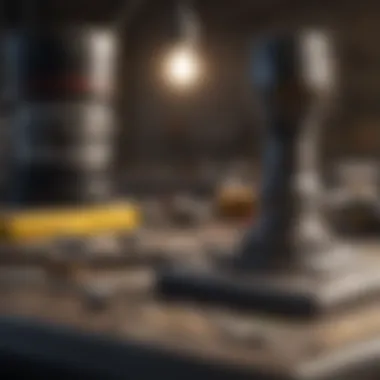Understanding Figure Area: Principles and Applications


Intro
The concept of figure area is fundamental in multiple fields. Whether in architecture or environmental science, understanding how to calculate the area of various shapes is crucial. This article aims to explore the principles of area measurement, its application, and tools to ensure accuracy.
Feature Spotlight
Exceptional Architectural Designs
Architecture relies heavily on accurate area calculations. The area of a building determines material usage, cost, and spatial planning. Architects like Frank Lloyd Wright intricately designed spaces by considering how each area would function. Not only does the aesthetic aspect matter, but also the efficiency of space usage. Familiarizing oneself with calculating square footage is essential in creating exceptional designs that are both practical and inspiring.
Unique Decor Elements
Innovative decor often depends on understanding the area of walls, floors, and other surfaces. For instance, deciding how much paint to purchase for a room requires knowledge of the area that needs coverage. Additionally, selecting furniture requires understanding these measurements to ensure everything fits well without overcrowding the space. Understanding figure area not only aids in practical decisions but also enhances the overall design vision.
Measurement Techniques
Basic Geometry in Area Calculation
In geometry, the area can be calculated using specific formulas based on the shape. For squares, the formula is:
For rectangles:
Triangles and circles also have distinct calculations. The knowledge of these formulas is essential for anyone working with physical spaces, ensuring that designs are feasible.
Tools for Accurate Measurement
Using tools like laser distance measurers or mobile applications can improve the accuracy of area measurements. These modern devices can minimize human errors often present in traditional measuring techniques. With advanced technologies, professionals can easily gather precise data, leading to better outcomes in design projects.
"Accurate measurements form the foundation of effective design and planning across all fields."
Practical Applications in Architecture and Planning
In architecture, understanding figure area influences various phases, from design to construction. Architects must calculate areas to create compliant structures per building codes. Environmental planners likewise use area calculations to assess spaces for parks, developments, or conservation areas.
Understanding area also extends to real estate. Buyers must recognize space measurement to make informed purchasing decisions. Agents often highlight total area, and knowing this is pivotal for negotiations. The importance of figure area, therefore, resonates beyond theoretical implementation—it pervades everyday decisions in multiple sectors.
The End
This article offered insight into how figure area influences not just the architecture we appreciate but also our daily lives.
Foreword to Figure Area
Understanding the area of different figures is fundamental in mathematics and various real-world applications. The area represents the extent of a surface and is crucial in fields like architecture, real estate, and environmental science. Grasping the principles of area allows professionals to make informed decisions about space utilization, material requirements, and design implications.
Mathematical calculations of area serve clear purposes. They help individuals visualize spatial arrangements and optimize designs. Moreover, accuracy in area measurement can influence financial investments. This section introduces the key elements of figure area and establishes its relevance in both theoretical and practical contexts.
Defining Area in Geometric Terms
Area is defined as the amount of two-dimensional space a shape occupies. This measure is typically expressed in square units, such as square meters or square feet. Simple geometric shapes have standard formulas to calculate their area, which makes this understanding more straightforward. For instance:
- Square: Area = side × side
- Rectangle: Area = length × width
- Triangle: Area = 0.5 × base × height
- Circle: Area = π × radius²
Each shape follows specific rules, and learning them is vital for accurate area measurement. The application of these formulas can extend to more complex shapes by breaking them down into simpler segments. Understanding area in this context not only supports theoretical knowledge but also enhances problem-solving skills.
Importance of Area in Mathematics and Real Life
In mathematics, the concept of area is not merely academic; it has intricate ties to real-life situations. In fields like real estate, knowing the area of properties helps in making informed purchasing decisions. Similarly, architects rely on area calculations for designing functional and aesthetic spaces.


In environmental management, area measurement plays a crucial role in land assessment and resource allocation. Understanding land areas is fundamental for conservation efforts and urban planning. By comprehending the relevance and implications of area, individuals can better navigate quantitative challenges in various fields.
Accurate area calculations are vital for effective planning and resource management.
This exploration of figure area will not only cover its mathematical foundations but also emphasize its applications across different sectors, enhancing the reader’s appreciation of this essential concept.
Mathematical Foundations of Area Calculation
Understanding the mathematical foundations of area calculation is essential for accurate measurement and effective application across various fields. Area serves as a principal descriptor of two-dimensional space, allowing us to quantify the extent of surfaces we encounter in everyday life. Grasping the mathematical principles underlying area calculation enhances our ability to engage with complex shapes and fosters a deeper understanding of geometric relationships. This section will explore basic formulas for common shapes as well as advanced techniques for calculating areas of more complex figures.
Basic Formulas for Common Shapes
Squares and Rectangles
Squares and rectangles are foundational shapes in geometry. Their area can be calculated using a simple formula:
- Area = Length × Width
A crucial aspect of squares and rectangles is their straightforward and intuitive geometric properties. These shapes have four right angles, and opposite sides are equal in length, which makes them easy to measure. Their simplicity is the reason why they are widely used in design and architecture. One significant feature is the ability to use a single measurement (the length of one side for squares) to determine the entire area. This property makes squares and rectangles beneficial for various applications, from construction plans to land division. However, the limitation comes in addressing non-linear surfaces, which cannot be encapsulated by this formula.
Triangles
The triangle is another fundamental geometric figure, essential in both pure and applied mathematics. The area calculation for triangles is different from squares and rectangles, following this formula:
- Area = 0.5 × Base × Height
What sets triangles apart is their versatility. They can be used to form other shapes and are vital in trigonometry. Triangles have varying types, including equilateral, isosceles, and scalene, each possessing unique characteristics. This adaptability makes them a popular choice in architecture and engineering, vital for frameworks and structural integrity. Nevertheless, one challenge in calculating the area arises when height is not readily apparent, necessitating additional measurements.
Circles
Circles introduce a more complex area calculation due to their continuous curves. The formula to calculate the area is:
- Area = π × Radius²
Circles possess a key characteristic in that every point on the boundary is equidistant from the center. This symmetry lends circles their unique applications in various fields, especially in engineering and design. Their ability to provide efficient space utilization is advantageous; however, the reliance on the irrational number π presents one drawback in calculations requiring precision and can complicate interpretations in educational contexts.
Polygons
Polygons, or multi-sided figures, expand the complexity of area calculation further. The area differs based on the type of polygon. For regular polygons, formulas can be applied, while irregular polygons often require more intricate calculations involving dividing them into simpler shapes. The basic formula is as follows for a regular polygon:
- Area = (Perimeter × Apothem) / 2
The versatility of polygons allows them to appear in numerous applications, from art to architecture. Polygons have varying sizes and orientations, making them appealing but also challenging in measurement. This can lead to higher chances of error during calculations and demands a thorough understanding of geometry to ensure accurate results.
Advanced Techniques for Complex Shapes
Inclusive Methods
Inclusive methods in area calculation refer to techniques designed to address irregular figures or shapes with varying geometries. These methods allow users to adapt basic formulas to compute areas that do not conform neatly to standard shapes. One notable approach involves overlaying geometric grids and calculating individual areas before summation. This method broadens the application of area calculation in complex real-world scenarios and builds on the fundamental importance of understanding dimensional relationships within geometry. Advantages include better accuracy and an increased ability to visualize space, but they may also demand advanced tools and methods for practical application.
Approximation Strategies
Approximation strategies play a vital role in measuring complex shapes where precise calculations are challenging. These involve simplifying the calculation process by estimating the shape's area through the use of known geometric figures. For instance, irregular areas might be approximated using bounding rectangles or circles. While simplifying the process, approximation methods may lead to a degree of uncertainty, particularly when high precision is required. Nevertheless, they enable quick estimations in situations where detailed measurements are impractical or time-consuming.
The understanding of mathematical foundations in area calculation is crucial for anyone involved in areas like architecture, engineering, and design. Addressing both basic and advanced techniques ensures that practitioners can approach a wide range of measurement challenges with confidence.
Measurement Techniques
Measurement techniques play a crucial role in understanding figure area. They determine how accurately we can calculate areas and contribute significantly to various fields such as architecture, engineering, and environmental science. Knowing the right method can lead to precise data, enabling informed decision-making in real-world applications. Different methods serve distinct purposes, from simple manual techniques to advanced digital tools. Each choice has its benefits and considerations, affecting the overall reliability of the area measurement.
Manual Measurement Approaches
Rulers and Measuring Tapes


Rulers and measuring tapes are fundamental tools in manual measurement. They offer a straightforward and practical approach to calculating area for simple shapes. The key characterstic of these tools is their portability and ease of use in everyday situations. A ruler is particularly effective for measuring smaller objects, while a measuring tape can handle larger distances, making them versatile choices.
Unique features include:
- Scalability: Both tools can measure varying lengths, which is useful for comparing dimensions directly.
- Accessibility: Easily found in school or home environments, making them popular among students and professionals alike.
However, they have disadvantages, such as limited precision for irregular shapes. Manual measurement can introduce human error, affecting the accuracy of area calculations.
Grid Paper Method
The grid paper method provides a unique approach to estimating area visually. It is beneficial for beginners learning to calculate area, as it combines geometry with simple counting. The main characteristic of this method is its visual representation of space, which allows for easy estimation of area covered by shapes.
Unique features include:
- Visualization: Helps users see shapes as composed of smaller squares, making calculations more intuitive.
- Low-cost: Requires only basic materials, making it accessible for most users.
However, the grid paper method may lack the precision of technical tools, especially for irregular figures, which could lead to inaccuracies. Yet, it remains a popular choice for educational purposes and simpler projects.
Digital Measurement Tools
Laser Distance Meters
Laser distance meters have gained significant popularity in recent years due to their accuracy and efficiency. These tools use laser technology to obtain precise measurements over long distances quickly. The key characteristic of laser distance meters is their ability to calculate measurement instantly with minimal human intervention.
Unique features include:
- High accuracy: Capable of calculating measurements within millimeters, advantageous for professional applications.
- Speed: Provides almost instant results, reducing the time needed for measurements compared to traditional methods.
Despite their advantages, laser meters can be more expensive than manual tools. Additionally, they require a line of sight to the target, which may limit usability in certain environments.
3D Scanning Technologies
3D scanning technologies represent the forefront of area measurement innovation. They can capture entire spaces and complex shapes, providing detailed area data. The main characteristic of this technology is its ability to create a digital representation of objects or environments.
Unique features include:
- Comprehensive data: Can capture intricate geometries and spatial relationships, useful in detailed architectural planning.
- Versatility: Applicable in various fields, from construction to environmental management.
However, 3D scanning can be costly and requires specialized training to operate. Additionally, processing the scanned data can be time-consuming and may not be practical for quick measurements. Despite these limitations, the technology’s advantages make it a favored option among professionals seeking high-precision area measurements.
Challenges in Figure Area Calculation
Calculating the area of various geometric figures can present numerous challenges. Understanding these challenges is vital for ensuring precision in practical applications, whether in architecture, landscaping, or environmental management.
Accurate area measurement informs decision-making processes that impact design, resource distribution, and even ecological preservation. Thus, addressing the challenges surrounding area calculation is not just a matter of academic interest; it is essential for real-world efficacy and success.
Overcoming Measurement Errors
Measurement errors can arise from a variety of sources, leading to inaccuracies that affect the overall data integrity. These errors may stem from human oversight, the limitations of measuring tools, or even environmental factors. Common types of measurement errors include:
- Parallax Error: It occurs when a measurement is taken at an angle, causing a misread. Proper positioning during measurement can mitigate this.
- Tool Calibration Issues: Outdated or improperly calibrated tools can yield incorrect readings. Regular calibration is necessary for tools like laser distance meters and measuring tapes.
- Human Error: Errors may arise due to miscalculations, misunderstanding of formulas, or inefficient measurement techniques. Education and training in measurement protocols can significantly reduce these errors.
To effectively combat these challenges, it is prudent to implement the following strategies:
- Routine Calibration: Ensure all measuring tools are regularly calibrated to maintain their accuracy.
- Double-check Measurements: Employ a secondary method for verification, such as manual measurement alongside digital tools.
- Training and Awareness: Provide education for personnel on optimal measurement techniques to reduce human errors.
"The accuracy of measurements can greatly affect the outcomes of projects, making it essential to understand common pitfalls in proximity measurement."
Addressing Irregular Shapes
Irregular shapes present unique challenges that standard formulas cannot easily address. In real-life applications, many objects do not conform to the basic geometric shapes. This necessitates innovative strategies to calculate their areas effectively.


To tackle these issues, one can utilize:
- Decomposition Method: This involves breaking down an irregular shape into simpler geometric figures, calculating each part, and then summing the areas.
- Grid Method: Overlaying a grid on the shape allows for estimation by counting the full and partial squares covered by the figure.
- Integration Techniques: For more complex curves, calculus can be employed to determine the area under a curve, which is essential in fields like engineering and architecture.
Keeping track of these methods and employing suitable techniques tailored to specific situations allows for a much higher level of accuracy in area calculation.
Applications of Area Measurement
Understanding area measurement plays a crucial role in multiple disciplines. Its relevance extends beyond basic geometry, impacting a variety of fields from architecture to environmental management. The concept of area is fundamental when planning and executing real-world projects. This section delves into specific applications where area measurement is indispensable.
Architectural Design and Land Use
In architectural design, precise area measurements influence everything from layout to zoning regulations. Architects use area calculations to determine the optimal use of space in buildings. For instance, knowing the area of different rooms helps in planning furniture arrangements and ensuring accessibility.
Moreover, area measurement affects land use planning. Local governments rely on zoning laws that dictate how land can be utilized, often based on its measured area. This influences residential development, commercial placement, and green spaces—making accurate calculations vital for sustainable urban growth.
"Accurate area measurement ensures that every square foot is utilized effectively, leading to functional and aesthetically pleasing designs."
Key considerations in architectural design include:
- Functional Requirements: Areas must accommodate their intended uses while maintaining comfort and flow.
- Regulatory Compliance: Structures must adhere to local codes that often tie back to measured areas.
- Cost Implications: Efficient use of area can lead to significant savings in materials and labor.
Environmental Management
Area measurement is equally important in environmental management. It allows for better resource allocation and conservation efforts. For example, measuring the area of forested land can help to calculate carbon sequestration capacity. Similarly, assessing the area of wetlands provides insight into biodiversity and ecosystem health.
Additionally, governments and organizations use area measurements in environmental impact assessments. This helps assess how new developments might affect surrounding habitats and species.
Here are several benefits of area measurement in environmental management:
- Conservation Efforts: Understanding the area helps in identifying critical habitats that need protection.
- Resource Management: Accurate area data enables effective management of natural resources.
- Policy Development: Area measures inform regulations that seek to protect the environment while allowing for development.
Evolution of Area Measurement Technology
The evolution of area measurement technology represents a significant advancement in our ability to assess and analyze space. From the rudimentary methods of the past to the sophisticated tools available today, this evolution has broad implications. It enhances the accuracy of measurements, promotes efficiency, and allows for precise area calculations across various fields. Real estate, architecture, and environmental management are among the areas that benefit most from these advancements.
From Manual Tools to Digital Solutions
Historically, measuring area involved basic manual tools such as rulers, measuring tapes, and even physical strides to gauge distance. These methods, while effective in certain contexts, came with a host of limitations. Manual measurements often led to human error, particularly when dealing with irregular shapes or large areas.
With the advent of digital solutions, these challenges have been dramatically reduced. Technologies like laser distance meters have transformed the landscape. These devices provide quick and accurate area calculations by measuring the distance between points with precision. Additionally, tools like Drone technology now allow for aerial measurements, making it feasible to assess extensive or complex terrains quickly. The shift toward digital tools has made measurement more accessible and accurate than ever before.
Future Trends in Area Measurement
As technology continues to develop, future trends in area measurement are poised to revolutionize the field further. One noteworthy trend is the use of artificial intelligence and machine learning to enhance measurement accuracy. Algorithms can analyze data from scans and provide more detailed insights about the dimensions and shapes being measured.
Another promising trend is the increasing integration of augmented reality in measurement processes. These tools allow users to visualize measurements in real-time, improving understanding of the spatial relationships within a given area.
The emergence of remote sensing technology also cannot be understated. As we become more concerned with environmental management, the ability to gather geographical data from satellite imagery offers a high-level overview of land use patterns and changes over time.
Ending
The conclusion serves a pivotal role in synthesizing the details of figure area within this article. It draws together the varied elements discussed, enabling readers to grasp the overall significance of area measurement in both theoretical and practical contexts. Understanding how to accurately calculate and apply area measurements impacts numerous fields—architecture, environmental science, and urban planning—demonstrating its real-world relevance.
Summary of Key Insights
In summary, this article has expounded on crucial concepts surrounding figure area. Key insights include:
- Mathematical Foundation: Proficiency in basic and advanced area formulas is fundamental.
- Measurement Techniques: The choice between manual approaches and digital tools can affect accuracy and efficiency.
- Challenges: Common issues include handling measurement errors and calculating the area of irregular shapes.
- Applications: The relevance of accurate area calculations in diverse fields emphasizes their importance in practical scenarios.
- Technological Evolution: Advances in technology, ranging from rudimentary tools to sophisticated digital solutions, continue to reshape how we approach area measurement.
This comprehensive perspective allows readers to appreciate the multidisciplinary applications of area measurement, fostering a connection between mathematical principles and their implementation.
Implications for Future Work
The implications drawn from an in-depth understanding of figure area are substantial for various professionals and enthusiasts. Future work can focus on a diverse range of areas, including:
- Refinement of Measurement Technologies: There is room for innovation in digital measurement tools.
- Educational Opportunities: Emphasizing the practical applications of area in educational contexts can enhance learning outcomes in mathematics and science.
- Real-World Applications: Exploring new applications of area measurement can improve designs in architecture and efficiency in land use.
As industries evolve, incorporating the nuances of figure area assessment into project frameworks can lead to more informed decision-making and optimized outcomes. Understanding figure area represents just the beginning of a broader exploration into how these principles can be applied in practical and innovative ways.







